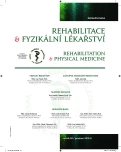The Inclination and Shape Modulation of Cervicothoracic Connection of Spine Provoked by External Rotation of the Arm
Authors:
I. Jelínková; M. Šorfová
Authors‘ workplace:
Katedra fyzioterapie FTVS UK, Praha
vedoucí katedry doc. PaedDr. D. Pavlů, CSc.
; Katedra anatomie a biomechaniky, FTVS UK, Praha
vedoucí katedry doc. PaedDr. K. Jelen, CSc.
Published in:
Rehabil. fyz. Lék., 20, 2013, No. 4, pp. 211-214.
Category:
Original Papers
Overview
It is generally accepted that the forward head posture is not caused only by the imbalances in the muscles of the upper body. The upright posture of the cervical-thoracic spine was provoked by an external humeral rotation and adduction of the shoulder that results in an increased activation of the external humeral rotators and the latissimus dorsi muscle. Twenty subjects (4 men: 24.5 ± 4.3 years; 16 females: 24 ± 2.5 years without pathology or injury of the pelvis, shoulder girdle and spine were recruited. The kinematics of the cervical-thoracic spine and the inclination of the pelvis were measured in the sagittal plane with a motion analysis system. The Z axis intersected TH1-TH12-SIPS in the case of the upright posture. The correlation (Pearson r = - 0.96; p < 0.01) was achieved between the inclination of the pelvis and the upright posture.
Keywords:
upright posture, cervicothoracic connection of spine, pelvis ant-version, upper cross syndrome, forward posture, open scissors syndrome
Sources
1. AWAD, M., ALLAH, A.: Relationship between thoracic kyphosis and trunk length in adolescence females. Am. J. Sci., 2012, 8, s. 580-583.
2. BERGLUD, K. M., PERRSON, B. H., DENISON, E.: Prevalence of pain and dysfunction in the cervical and thoracic spine. Manual Ther., 2008, 13, s. 295-299.
3. BONNEY, R. A., CORLETT, N.: Head posture and loading of the cervical spine. Appl. Ergon., 2002, 33, s. 415-417.
4. CANEIRO, J. P. et al.: The influnce of different sitting postures on head/neck posture and muscle activity. Manual Ther., 2010, 15, s. 54-60.
5. CARLSON, J. M.: Clinical biomechanics of orthotic treatment of thoracic hyperkyphosis. J. Prosthet. Orthot., 2003, 15, s. 31-35.
6. CORREA, E., BERZIN, F.: Efficacy of physical therapy on cervical muscle activity and on body posture in school-age mouth breathing children. Int. J. Pediatr. Otorhi., 2007, 7, s. 1527-1535.
7. DIVETA, J., WALKER, M. L., SKIBINSKI, B.: Relationship between performance of selected scapularmuslces and scapular abduction in standing subjects. Phys. Ther., 1990, 8, s. 470-476.
8. FALLA, D. et al.: Recruitment of the deep cervical flexor muscles during a postural-correction exercise performed in sitting. Manual Ther., 2007, 12, s. 139-143.
9. HARRISON, D. E. et al.: Concurent validity of flexicurve instrument. Measurements: Sagittal skin contour of the cervical spine compared with lateral cervical radiographic mesurements. J. Manipulative Physiol. Ther., 2005, 8, s. 597-603.
10. CHESHOMI, S., RAJABI, R., ALIYADEH, M. H.: The relationship between thoracic kyphosis curvature, scapular position and posterior shoulder girdle muscles endurance. J. Appl. Sci., 2011, 14, s. 1072-1076.
11. KENDALL, F. P.: Muscles: testing and fuction with posture and pain. Philadelphia, Williams and Wilkins, 2010, s. 482.
12. KOLÁŘ, P., LEWIT, K.: Význam hlubokého stabilizačního systému v rámci vertebrogenních obtíží. Neurol. Prax., 2005, č. 5, s. 258-262.
13. MCAVINEY, J. et al.: Determination the relationship between cervical lodosis and neck complaints. J. Manip. Physiol. Ther., 3, 2005, 28, s. 187-193.
14. MORRIS, C. E. et al.: Vladimir Janda, MD, DrSc; tribute to a master of rehabilitation. Spine, 2006, 31, s. 1060-1064.
15. OTÁHAL, S., TICHÝ, J.: Zřetězení svalových spazmů - aspekt neurologický a biomechanický. Rehabil. fyz. Lék., 1996, č. 4, s. 174-178.
16. O'SULLIVAN, P. et al.: The effect of different standing and sitting postures on trunk muscle activity in a pain-free population. Spine, 2002, 11, s. 1238-1244.
17. RICHTER, P., HEBGEN, E.: Trigger points and muscle chains in osteopathy. New York, Thieme, 2009, s. 7.
18. SMÍŠEK, R., SMÍŠKOVÁ, K., SMÍŠKOVÁ, Z.: Spirální stabilizace: léčba a prevence bolestí zad. Praha, Smíšek R., 2011, s. 149.
19. VALIHRACH, J.: Bolesti při funkčních onemocněních pohybového aparátu dle konceptu Dr. Bruggera. Neurol. Prax., 2003, č. 4, s. 197-199.
20. VETTE, A. H. et al.: A comprehensive three-dimensional dynamic model of the human head and trunk for estimating lumbar and cervical joint torques and forces from upper body kinematics. Med. Eng. Phys., 34, 2012, s. 640-649.
Labels
Physiotherapist, university degree Rehabilitation Sports medicineArticle was published in
Rehabilitation & Physical Medicine

2013 Issue 4
Most read in this issue
- Combined Training of Closed and Open Kinematic Chains in Rehabilitation Exemplified by the FLOWIN® System
- Osteochondral Articular Junction and Osteoarthrosis
- The Observation of the Dynamics of a Clinical Picture in a Chronic Cervicobrachial Syndrome with the Aid of the Principles of McKenzie Concept
- The Inclination and Shape Modulation of Cervicothoracic Connection of Spine Provoked by External Rotation of the Arm
